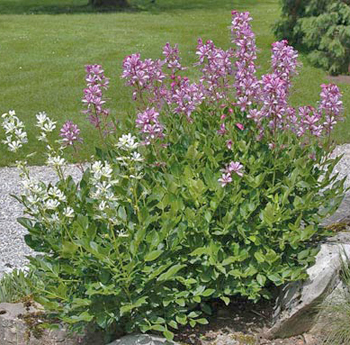Contents:
Common Names | Parts Usually Used | Plant(s) & Culture | Where Found | Medicinal Properties
Legends, Myths and Stories | Uses | Formulas or Dosages | Warning | Bibliography
Scientific Names

- Dictamnus albus L.
- Rutaceae
- Rue family
Common Names
- Bastard dittany
- Burning Bush
- Diptam
- Dittany
- False dittany
- Gas plant
- Pai-hsien (Chinese name)
- White dittany
Parts Usually Used
Rootstock, herb, seed
Back to Top
Description of Plant(s) and
Culture
Fraxinella is a perennial plant; the knobby, cylindrical, whitish rootstock sends up several round, downy, green-and-purple stems with alternate, odd-pinnate leaves. Leaflets are ovate-lanceolate, serrate, and covered with glandular dots. A long raceme of large, rose-colored (sometimes white or red-purple) flowers with darker veins appear in June and July. The fruit is a 5-parted capsule. The entire plant has a lemon-like smell. Some of the plant’s names refer to its production of a flammable substance in the summer which ignites with a flash over the whole plant but without harming it.
(There are several plants referred to as dittany: American dittany (Cunila origanoides) of the mint family; American dittany has another old name (Cunila mariana).
Back to Top
Where Found
Introduced from Europe and sometimes cultivated as a garden ornamental in the northern United States.
Back to Top
Medicinal Properties
Anthelmintic, diuretic, emmenogogue, expectorant, febrifuge, tonic
Back to Top
Legends, Myths and Stories
According to a pioneer doctor: Native Americans of the southeast smoked the fragrant leaves of this herb in place of tobacco.
The volatile oil from the flowers is emitted as a vapor on sultry summer evenings and if a match is lit, will flash.
Back to Top
Uses
A decoction of the rootstock is used for fever and stomach cramps, kidney stones and bladder stones.
Infusion of the flowers used to hasten childbirth, promotes the onset of menstruation. According to Parkinson, it was used against contagious diseases and pestilence. A tincture of the leaves and flowers is used in a liniment for rheumatic pains.
Back to Top
Formulas or Dosages
Infusion or decoction: use 1 tbsp. rootstock, herb, or seed with 1 cup water. Take 1 cup a day, a mouthful at a time.
Back to Top
Warning
Contact with the plant may cause dermatitis where the skin is subsequently exposed to sunlight.
Avoid use during pregnancy.
Back to Top
Bibliography
![]() Culpeper’s Complete Herbal & English Physician: Updated With 117 Modern Herbs
Culpeper’s Complete Herbal & English Physician: Updated With 117 Modern Herbs, by Nicholas Culpeper, Meyerbooks, publisher, PO Box 427, Glenwood, Illinois 60425, 1990, (reprint of 1814)
![]() Chinese Medicinal Herbs
Chinese Medicinal Herbs, compiled by Shih-Chen Li, Georgetown Press, San Francisco, California, 1973.
![]() Eastern/Central Medicinal Plants
Eastern/Central Medicinal Plants, by Steven Foster and James A. Duke., Houghton Mifflin Company, 215 Park Avenue South, New York, NY 10000
![]() The Herbalist Almanac
The Herbalist Almanac, by Clarence Meyer, Meyerbooks, publisher, PO Box 427, Glenwood, Illinois 60425, copyright 1988, fifth printing, 1994
![]() The Herb Book
The Herb Book, by John Lust, Bantam Books, 666 Fifth Avenue, New York, NY. copyright 1974.
 Old Ways Rediscovered
Old Ways Rediscovered, by Clarence Meyer, Meyerbooks, publisher, PO Box 427, Glenwood, Illinois 60425, published from 1954, print 1988
![]() Webster’s New World Dictionary
Webster’s New World Dictionary, Third College Edition, Victoria Neufeldt, Editor in Chief, New World Dictionaries: A Division of Simon & Schuster, Inc., 15 Columbus Circle, New York, NY 10023
 The Rodale Herb Book: How to Use, Grow, and Buy Nature’s Miracle Plants (An Organic gardening and farming book)
The Rodale Herb Book: How to Use, Grow, and Buy Nature’s Miracle Plants (An Organic gardening and farming book), edited by William H. Hylton, Rodale Press, Inc. Emmaus, PA, 18049., 1974
